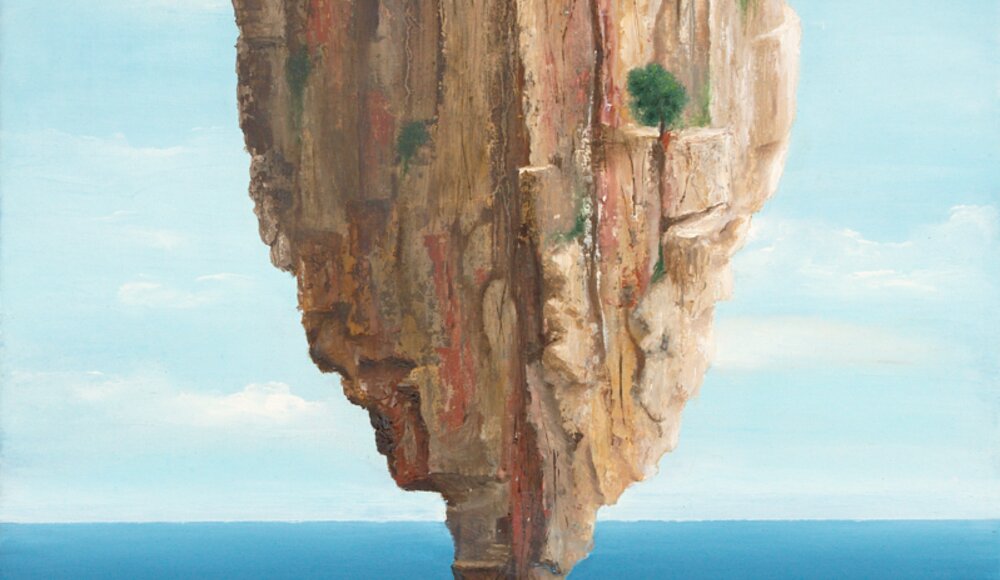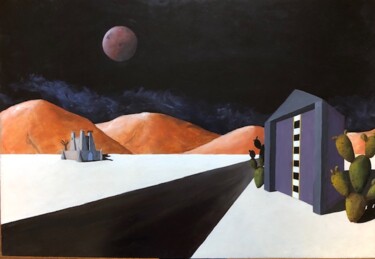Basic Concepts of Surrealism
When we have the time to fantasize a little with our minds, I mean now on the rare occasions when we are not working, not in the company of people or phone devices full of compulsive and nagging images or videos, we can look at our surroundings, sometimes animating, changing or enriching them with the content of our minds, often associated with the material provided to us by our unconscious, which psychologists would surely link back to our most unresolved childhood traumas. What I have just attempted to explain was accomplished, through the medium of painting, photography, sculpture, etc., by the Surrealists, whose art also revisited in this sense the genre of landscape, into which they channeled the unconscious, precisely to unlock the power of the imagination, too often silenced by the more rational exercise of the mind.
In fact, according to the exponents of André Breton's movement, it is precisely when we leave the latter free to express itself, that we can come to know the contradictions that animate the world, as well as the essence of things and the actual workings of our thinking, ready to come to life in a parallel "super-reality." The images drawn from this exercise, which can also be found in the Surrealist landscape genre, are sometimes expressed through the contrivance of optical illusion, intended to defeat the shaky boundary that exists between illusion and reality, making us understand how art allows the real and the imagined to be juxtaposed in order to make us contemplate them in unison in the same depiction.
 DIARY SERIES VII (2022)Painting by Muhammet Bakır
DIARY SERIES VII (2022)Painting by Muhammet Bakır
 THE BEAUTIFUL YESTERDAY OF MY TOMORROW (2023)Painting by Nazabal.
THE BEAUTIFUL YESTERDAY OF MY TOMORROW (2023)Painting by Nazabal.
Surrealist Illusion Landscapes
To demonstrate what has been said so far, I leave the floor to some landscape masterpieces in the history of art, created by masters such as Dali, Magritte and Ernst. Starting with the former, I begin with the following description: an earthy landscape, placed near an expanse of water furrowed by ships, hosts, in addition to some mountains, a body of water, capable of becoming the focus of the entire pictorial narrative. The latter actually houses three large swans, whose reflection, enhanced by the presence of dry trees, is transformed into the frontal figures of three elephants. Also present on the scene, but practically intent on ignoring it, is a man, realized in shades, which, akin to those of the brown highlands, seems almost to be part of it with his static and pensive figure.
Swans Reflecting Elephants (1937), the work just described, was made with an additional component of the Surrealist movement, namely the frequent reference to dream reality, in which Dali, like other masters of the movement, recognized the purest expression of the individual's unconscious. In fact, it is during sleep that the inner world is unleashed, revealed through associative mechanisms untied from the rules of everyday life, which the Spaniard deliberately rendered in a hyperrealistic style, ready to make fantastical situations as verisimilar as possible. In addition, the artist, who as described above made clear use of the "trick" of optical illusion, materialized especially in the animal and human presence, leads us to the description of another technically related masterpiece: Rene Magritte's The Blank Signature (1965).
In the latter painting, the impossible superimposition of the three images depicted in unison, such as those of the woman on horseback, the trees and the naturalistic background, appears evident, a clear result of a vision contrivance, similar to that used by Schuster for his famous "fork," an image ready to provide us with contradictory information, aimed at thwarting a clear and stable elaboration of the depicted subject. To make you understand: when we look at Magritte's masterpiece, at first glance we see an image, the various elements of which are united into a coherent whole.
Through closer study, however, we realize how, for example, the horse cannot be in front of the tree and, at the same time, behind the background. It is precisely this latter impossibility that is made acceptable by my mind, which, in each case, is able to unite all the individual elements of the work, generating something coherent, that is, beyond the predominant inconsistency. We come at last to Ernst's Nature at Dawn (1936), a work in which there is no real optical illusion, but such a chromatic affinity that the plant world is confused with the animal world, ready to take on the appearance of an anthropomorphic bird, whose nest, in reality, resides only in the fantasies of our unconscious.
In fact, the painting translates into painting the master's personal conception of artistic inspiration, the impulses of which would necessarily be derived from irrational erotic urges, well summarized by the figure of the bird in question, captured as it is intent on gazing longingly at the female figure crouching in the lower right-hand corner of the support. In addition, the relationship between art and the unconscious also recurs in the choice of the habitat of the jungle, a place linked to Ernst's childhood memories, who was somewhat disturbed by the vision of a similar subject, reproposed by his father Philippe's watercolor depicting the monk Caesar of Heisterbach in hermitage in the woods.
The latter's observation was precisely followed by a desire to define the forest as a psychosocial environment, in which nature is transformed into an aesthetic category, the experience of which is defined by the painter as follows: "The wonderful pleasure of breathing freely in a vast space and, on the other hand, the oppressive impression of being enclosed in a prison formed by the surrounding trees. Inside and outside at the same time. Free and imprisoned." Finally, the landscape genre, always trapped in the meanderings of our minds, again meets the stylistic features of Surrealism in the works of Artmajeur artists such as: Robert Inestroza, Andrey Kutilovsky and Gio Mondelli.
 PARADISE LOST & FOUND (2023)Painting by Robert Inestroza
PARADISE LOST & FOUND (2023)Painting by Robert Inestroza
PARADISE LOST & FOUND by Robert Inestroza
Marine eddies occur when fast ocean currents, circulating in different directions, collide with each other and begin to rotate around each other, such that they generate phenomena, which, depending on the volume and strength of the encounter, exhibit different extents. It is very likely that the vortex captured in the Inestroza landscape is a less intrusive phenomenon than the more fearsome maelstrom of the Saltstraumen Strait (Norway), considered the most powerful on the planet, as it presents at a speed of 40 km/h, capable of generating vortices up to ten meters wide and five meters deep. All these assumptions of mine stem from the fact that despite the presence of a conspicuous vortex in Paradise lost & found, the swimmers in the canvas quietly continue to sunbathe and play in the water, having perhaps interpreted the nefarious natural event in the same way as a massage effect from a pseudo pool. Here it is precisely in this contrasting image, i.e., aimed at showing actual danger without dramatic consequences, that we read the contribution of the Surrealist movement to Artmajeur's painter's point of view, whose work is often testimony to a contradictory vision of contemporary life, ready to strategically mix chaos and poetry, fragility and strength, as well as the ephemeral and the eternal. All this is often presented with extreme levity, ready to naturally evoke events of the past, as well as allude to those of the present, while also trying to foretell those of the future.
 BIG STONE (2022)Painting by Andrey Kutilovsky
BIG STONE (2022)Painting by Andrey Kutilovsky
BIG STONE by Andrey Kutilovsky
A vibrantly inhabited island rises from the earthly crust to float above the ocean, perhaps exploded by the latter, due to the sort of water vortex that should have instead unleashed hell in the work described above. In any case, Kutilovsky's storm would have subsided, fixing on the medium an unreal, but rather quiet, pleasant and relaxed landscape vision. The surrealist component of the work in question, i.e. Big stone, seems quite evident, but at the same time already suggested to us in its basic concept by some details present in another masterpiece of art history: the Temptation of St. Anthony by Salvador Dali. In fact, in the same way that we find it hard to believe that the rock painted by the artist of Artmajeur could actually stand from a very thin base of floating ground, it is equally hard to conceive that the architectures and the animals in the aforementioned Spanish masterpiece could actually rest on very thin legs. In any case, in The Temptation of St. Anthony it is the vastness of the divine message that makes everything possible, in this case, even the most disturbing and fantastic visions of the saint. The latter actually does his best to escape the images of sexual and lustful promises by wielding a crucifix in his hands, ready to exorcise whatever demonic is now part of his surreality.
 THE ISLAND OF LIFE (2006)Painting by Gio Mondelli
THE ISLAND OF LIFE (2006)Painting by Gio Mondelli
THE ISLAND OF LIFE by Gio Mondelli
The masterpiece by French painter Jean-Baptiste-Siméon Chardin, titled Soap Bubbles and dated between 1733 and 1734, depicts a young man blowing a soap bubble, a subject borrowed from the 17th-century Dutch tradition, to be interjected, due to the ephemeral nature of the bubble in question, as one of the most typical allusions to the transitory nature of human life. Then if we thought of the boy presented above as the creator of the large soap bubble, floating in the sky of Gio Mondelli's paintings, perhaps the work might appear more realistic, despite the disproportionate size of the aforementioned sphere, dutifully bringing us back to the Surrealist language. It is precisely the reference to the latter that has given rise to a quiet and dreamy landscape composition, enlivened by the joy that spreads from the vision of the light and carefree soap bubble, capable of wringing a smile especially from children, who might even want to touch the pictorial support to try to burst it. Speaking of Artmajeur's artist, Gio Mondelli focuses his work, always looking for new techniques, styles and trends to experiment with, mainly on the Symbolist and Surrealist language, through which he mostly deals with the genre of landscape, although he does not fail sometimes to turn his attention to themes with a more abstract flavor.


 Olimpia Gaia Martinelli
Olimpia Gaia Martinelli











